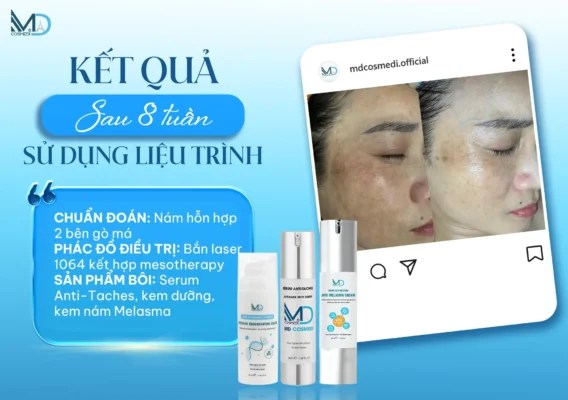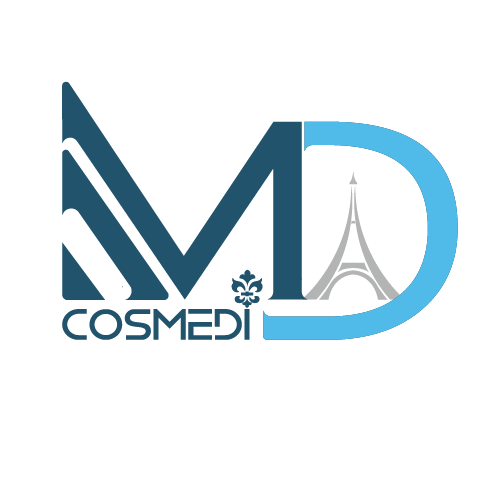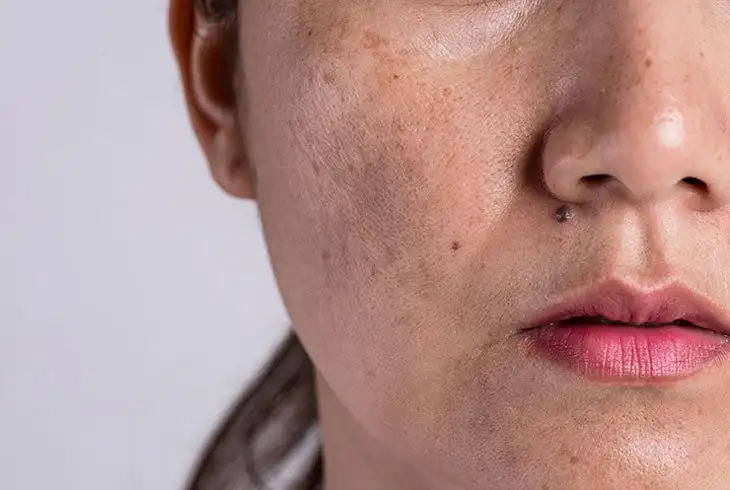No products in the cart.
Post-Inflammatory Hyperpigmentation (PIH): Causes and Effective Treatments for Acne Scars
Post-Inflammatory Hyperpigmentation (PIH): Understand the Causes & Treat Acne Scars
“The acne has just gone, the dark spots have come” – this is probably the most haunting cycle in the skin care journey. The stubborn dark spots and red spots that stick to the skin after the acne has subsided are a manifestation of post-inflammatory hyperpigmentation (PIH) .
PIH not only affects aesthetics but is also more “stubborn” than acne, making treatment difficult. Understanding the nature, causes and “golden time” for intervention is the only key to winning the battle against dark spots. Let’s join MD Cosmedi to clarify everything about PIH in this article.
1. What Exactly Is Post-Inflammatory Hyperpigmentation (PIH)?
Post-inflammatory hyperpigmentation (PIH) is a skin reaction. When the skin is damaged or inflamed (from acne, wounds, burns, or even cosmetic procedures), the pigment-producing cells (Melanocytes) are stimulated. They respond by producing large amounts of melanin (pigment) and push it to the surface of the skin, creating streaks and spots that are darker than the surrounding skin.
Simply put, PIH is the “remnants” of the battle your skin has just gone through, the body’s “over-the-top” defense mechanism. It’s important to remember: PIH is not a scar or a pitted scar (a loss of tissue), but a change in skin color .
2. Distinguishing the “Enemy”: Dark Spots (PIH) and Red Spots (PIE)
This is an extremely important step because “wrong identification, wrong treatment”. There are two main types of post-acne dark spots:
Post-Inflammatory Hyperpigmentation (PIH)
- Cause: Due to excess production of Melanin .
- Identification: Brown , black, or dark gray in color . Common in people with dark skin tones and when the pimple is deeply inflamed.
- How to check: When you press the skin tightly, the bruise does not disappear.
Post-Inflammatory Erythema (PIE)
- Cause: Due to damage to capillaries (blood vessels) under the skin during inflammation, not related to melanin.
- Identification: Red, pink, or purple in color . Common in people with light skin tones.
- How to check: When you press the skin tightly, the bruise will temporarily disappear (due to the blood being pushed away) and turn red again when you release your hand.
3. Main Causes That Make PIH Worse
Knowing the cause will help you prevent PIH in the first place.
- Level of Inflammation: The larger and deeper the acne (cystic acne), the higher the risk of leaving PIH and the darker the color.
- Mechanical Impact (Pimple Squeezing): This is the number 1 “culprit”. Squeezing and squeezing pimples incorrectly will cause more serious damage to the skin, causing an inflammatory reaction to flare up, “guaranteeing” a deep dark spot.
- Exposure to UV Rays: Sunlight is the “food” of melanin. If you do not protect your skin well, UV rays will stimulate the pigment cells to work harder, causing newly formed dark spots to become darker and stick around for many times longer.
4. Medical Standard Treatment Protocol for Post-Inflammatory Hyperpigmentation (PIH)
Treating PIH is a “two-front” battle: you have to put out the “fire” (inflammation) and deal with the “ashes” (melanin). The “golden time” is right when the pimple has just healed and begins to show signs of darkening.
Step 1: Control Inflammation & Prevent New Acne
You can’t treat dark spots successfully if new pimples keep coming back. The first priority is to control the pimples, but do it gently . Using harsh, irritating acne treatments can inadvertently aggravate the inflammation and cause more PIH .
Look for acne treatment products with the “3 NO” formula: No dryness – No peeling – No irritation. Active ingredients such as BHA, Zinc PCA and gentle Retinoid derivatives such as Retinyl Palmitate are ideal choices to soothe acne, control oil while still preserving the skin barrier.
Step 2: Inhibit Melanin Production (Lighten Dark Spots)
Along with acne treatment, you need to use “golden active ingredients” that can inhibit the enzyme Tyrosinase (melanin factory).
- Hydroquinone: Once the “gold standard,” but carries the risk of rebound pigmentation and irritation.
- Cysteamine & Tranexamic Acid: This is considered the perfect replacement “duo” of the new era. Cysteamine is a multi-target active ingredient, inhibiting melasma and acne scars powerfully but safely, without causing cell toxicity. Tranexamic Acid helps fade dark spots, prevents melanin production caused by UV rays and helps soothe the skin.
The combination of these two active ingredients, especially with Nanovectores coating technology to increase absorption and reduce irritation, will bring outstanding PIH fading effect.
Step 3: Absolute Skin Protection (Mandatory!)
This is a non-negotiable step. All your efforts to get rid of dark spots will be wasted without sunscreen. As mentioned, UV rays make dark spots darker.
Use a broad spectrum sunscreen with SPF 30-50+ and PA+++ or higher every day, even when you are indoors.
Conclude

Post-inflammatory hyperpigmentation (PIH) is a common skin condition, but it is completely manageable if you understand its nature and intervene properly. Don’t just focus on “erasing” dark spots, but treat them in parallel: gently control inflammatory acne and safely inhibit pigmentation .
MD Cosmedi ‘s philosophy is to provide medical-grade solutions that respect the skin’s protective barrier, helping you treat the root cause of acne without causing irritation (with Azeretin Cream ) and permanently resolve the consequences of dark spots (with Anti Melasma Cream ).




